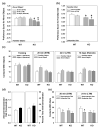Mice lacking synapsin III show abnormalities in explicit memory and conditioned fear
- PMID: 20050925
- PMCID: PMC2878384
- DOI: 10.1111/j.1601-183X.2009.00555.x
Mice lacking synapsin III show abnormalities in explicit memory and conditioned fear
Abstract
Synapsin III is a neuron-specific phosphoprotein that plays an important role in synaptic transmission and neural development. While synapsin III is abundant in embryonic brain, expression of the protein in adults is reduced and limited primarily to the hippocampus, olfactory bulb and cerebral cortex. Given the specificity of synapsin III to these brain areas and because it plays a role in neurogenesis in the dentate gyrus, we investigated whether it may affect learning and memory processes in mice. To address this point, synapsin III knockout mice were examined in a general behavioral screen, several tests to assess learning and memory function, and conditioned fear. Mutant animals displayed no anomalies in sensory and motor function or in anxiety- and depressive-like behaviors. Although mutants showed minor alterations in the Morris water maze, they were deficient in object recognition 24 h and 10 days after training and in social transmission of food preference at 20 min and 24 h. In addition, mutants displayed abnormal responses in contextual and cued fear conditioning when tested 1 or 24 h after conditioning. The synapsin III knockout mice also showed aberrant responses in fear-potentiated startle. As synapsin III protein is decreased in schizophrenic brain and because the mutant mice do not harbor obvious anatomical deficits or neurological disorders, these mutants may represent a unique neurodevelopmental model for dissecting the molecular pathways that are related to certain aspects of schizophrenia and related disorders.
Keywords: Synapsin III; behavior; conditioned fear; explicit memory; knockout mice.
Figures



Similar articles
-
Behavioral characterization of P311 knockout mice.Genes Brain Behav. 2008 Oct;7(7):786-95. doi: 10.1111/j.1601-183X.2008.00420.x. Epub 2008 Jun 30. Genes Brain Behav. 2008. PMID: 18616608 Free PMC article.
-
Hippocampus-specific deletion of BDNF in adult mice impairs spatial memory and extinction of aversive memories.Mol Psychiatry. 2007 Jul;12(7):656-70. doi: 10.1038/sj.mp.4001957. Epub 2007 Jan 30. Mol Psychiatry. 2007. PMID: 17264839 Free PMC article.
-
Behavioral abnormalities in synapsin II knockout mice implicate a causal factor in schizophrenia.Synapse. 2009 Aug;63(8):662-72. doi: 10.1002/syn.20643. Synapse. 2009. PMID: 19360855
-
Synapsin III: role in neuronal plasticity and disease.Semin Cell Dev Biol. 2011 Jun;22(4):416-24. doi: 10.1016/j.semcdb.2011.07.007. Epub 2011 Jul 30. Semin Cell Dev Biol. 2011. PMID: 21827867 Free PMC article. Review.
-
Behavioral profiles of inbred strains on novel olfactory, spatial and emotional tests for reference memory in mice.Genes Brain Behav. 2002 Jan;1(1):55-69. doi: 10.1046/j.1601-1848.2001.00005.x. Genes Brain Behav. 2002. PMID: 12886950 Review.
Cited by
-
Synapsin I Controls Synaptic Maturation of Long-Range Projections in the Lateral Amygdala in a Targeted Selective Fashion.Front Cell Neurosci. 2019 May 21;13:220. doi: 10.3389/fncel.2019.00220. eCollection 2019. Front Cell Neurosci. 2019. PMID: 31164805 Free PMC article.
-
Autism-related behavioral abnormalities in synapsin knockout mice.Behav Brain Res. 2013 Aug 15;251:65-74. doi: 10.1016/j.bbr.2012.12.015. Epub 2012 Dec 29. Behav Brain Res. 2013. PMID: 23280234 Free PMC article.
-
Synapsin III Regulates Dopaminergic Neuron Development in Vertebrates.Cells. 2022 Dec 2;11(23):3902. doi: 10.3390/cells11233902. Cells. 2022. PMID: 36497160 Free PMC article.
-
Parental origin impairment of synaptic functions and behaviors in cytoplasmic FMRP interacting protein 1 (Cyfip1) deficient mice.Brain Res. 2015 Dec 10;1629:340-50. doi: 10.1016/j.brainres.2015.10.015. Epub 2015 Oct 17. Brain Res. 2015. PMID: 26474913 Free PMC article.
-
Synapsin III in brain development.Oncotarget. 2016 Mar 29;7(13):15288-9. doi: 10.18632/oncotarget.8106. Oncotarget. 2016. PMID: 26993596 Free PMC article. No abstract available.
References
-
- Bast T. Toward an integrative perspective on hippocampal function: from the rapid encoding of experience to adaptive behavior. Rev Neurosci. 2007;18:253–281. - PubMed
-
- Bunsey M, Eichenbaum H. Paired associate learning in rats: critical involvement of the parahippcampal region. Behav Neurosci. 1995;107:740–747. - PubMed
-
- Crawley JN, Belknap JK, Collins A, Crabbe JC, Frankel W, Henderson N, Hitzemann RJ, Maxson SC, Miner LL, Silva AJ, Wehner JM, Wynshaw-Boris A, Paylor R. Behavioral phenotypes of inbred mouse strains: implications and recommendations for molecular studies. Psychopharmacology. 1997;132:107–124. - PubMed
Publication types
MeSH terms
Substances
Grants and funding
LinkOut - more resources
Full Text Sources
Molecular Biology Databases
Research Materials

